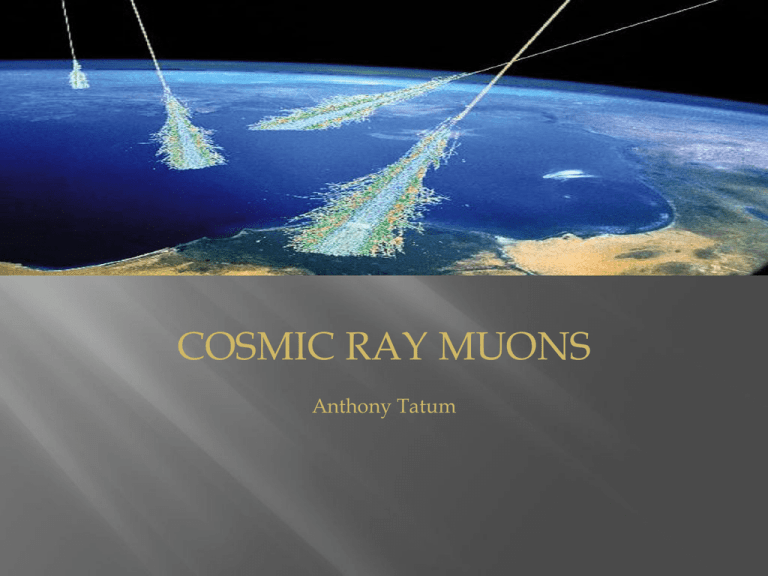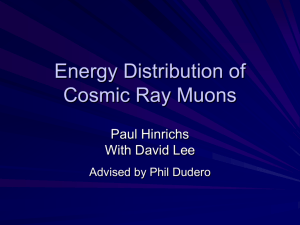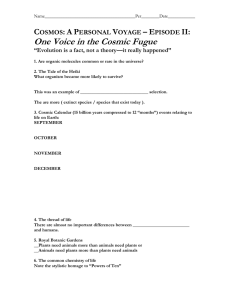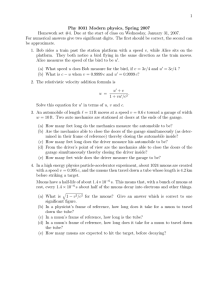COSMIC RAY MUONS Anthony Tatum
advertisement

COSMIC RAY MUONS Anthony Tatum What Is a Muon? Cosmic Origin and Interactions Muon Production and Path Effects in The Atmosphere Using Muons to Test Beam Profile Monitor Conclusion Discovered in 1936 Carl D. Anderson and Seth Neddermeyer Fundamental Similar Particle to Electron Lepton Mass is ~207 Times That of the Electron Interaction Gravitation Electromagnetism Weak Interaction Primary Decay Mode ~ 100% Property Value Muon Mass 105.6583668 ± 0.0000038 MeV Muon Electric Charge , (anti-muon) Mean Life 2.19703 ± 0.00004 µ seconds Spin 1/2 Magnetic Moment Ratio, µ/p 3.18334539 ± 0.00000010 Electric Dipole Moment Cosmic ray muons are created when high energy primary cosmic rays interact with earths atmosphere. The primary sources of cosmic rays are supernovae Components 89% Hydrogen Nuclei (Protons) Remaining 11% includes Helium, Carbon and Oxygen among other less abundant elements Gravitation Electromagnetism The equations of motion for primary cosmic rays interacting with earth’s magnetic field can be derived from the Lorentz force law. F ma q(v B) Manuel Vallarta Earth is approximated as a magnetic dipole High energy primary cosmic rays collide with atmospheric molecules at an altitude of ~ 15km to produce secondary cosmic rays Most abundant collisions Proton → N 2 Diatomic Molecule Proton → O2 Diatomic Molecule Protons, Neutrons, Pions, Kaons, Muons, Electrons and Photons Muons are the decay product of Pions and Kaons → → + + The mean energy of muons at the site of production (~15 km alt.) is 6 GeV. This energy corresponds to a velocity of .9998c. This velocity is derived from the relativistic equation for energy Time Dilation The lifetime of a 6 GeV cosmic muon as measured from Earth frame The incident angle of the majority of muons at sea level is close to the zero zenith angle 2 cm ~ 1 muon / minute Temperature Variance Interaction With Thunderstorms Temperature Variance Cosmic muon flux intensity corresponds directly with the atmospheric temperature at different pressures, altitudes and zenith angles Interaction With Thunderstorms The mean muon flux intensity has been observed to decrease during and near thunderstorms Lighting also effects the mean muon flux intensity during these thunderstorms Ionization and excitation processes Brehmsstralung Photonuclear and photonucleon interactions Primary mode of energy loss for low energy muons ( ~ 6 GeV) is through Ionization and Brehmsstralung Thomas Jefferson National Laboratory PrimEx Experimental Setup Purpose of the Beam Profile Monitor (BPM) Determine the beam position and entrance angles as well as its’ spatial and angular divergence The detector is situated to measure the x and y coordinates of the incident photon beam (Horizontal and Vertical from the lab frame) Internal structure of BPM (per module) ~ 64 Scintillating Fibers (2mm x 2mm x 13 cm) 4 groups of 16 light guides direct light into 4 photomultiplier tubes (PMT) 16 anode signals per PMT are processed by a discriminator One dynode signal per PMT Photomultiplier Tube (PMT) Discriminator Only allows anode signals that meet the prescribed parameters ECL Output Read on Scaler Defined logical signal when event occurs Analog Output Read on Oscilloscope Shows a more detailed signal Process High Low voltage power supply ~ - 850 V per PMT voltage power supply (electronic module) Connect detector to Oscilloscope and Scaler Setup Process Cont’d Ensure detector is free from light leakage Check for faults Measure event rate on the scaler and event amplitude on oscilloscope Data Retrieved Oscilloscope Significant electronic noise on module 3 Thermionic emission, leakage current Significant after pulsing present Residual gas, electrode glow No light leakage Confirmation of results Strong detection and signal processing on all channels of module 4 Gain deficiency on module 3 PMT’s Further investigation required to determine exact cause of the problem ECL Signals This data confirms the analog data Summary of the test PMT 4 on module 3 does not produce any signal The discriminator for PMT 2 on module 3 requires adjustment The high voltage power supply must be individually adjusted for each PMT on both modules Each channel per PMT requires software calibration Muons are fundamental particles that interact via gravitation, electro-magnetism and the weak interaction Cosmic muons are produced when primary cosmic rays interact with earths atmosphere Muon flux and energy is effected by atmospheric conditions Muons are beneficial to modern scientific research









